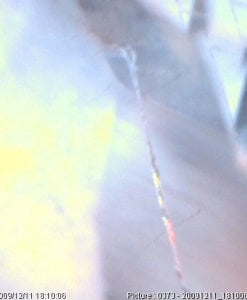Hello,
I have a cornflower blue (true color!) 13 crt. something or other stone.
I believe I know what it is based on my microscope pictures. I found all sorts of tiny inclusions that appear at high magnification. Howerver I tried to get pictures of the main inclusions I am trying to identify. It is a clear round rod shaped inclusion that starts near the table and has an angle of about 15 degrees and then corners at aboout 25 degrees down to what I call the mouth of the long rod. At the very end of the long rod it has silk coming out in three directions what look llike to me 60, and 120 degrees.However I am not positive about how exactly you measure the angles. Shoule I start with one set of silk like needles facing straight down and then measure the angle of the other two directions or?
I believe I have found a sapphire crystal within this stone. Within the long rod it appears to have crystals formed within that follow the length of the rod.
I have provided pictures and can provide more if needed. I have done tests with my chelsea filter, 10,20x loups. And used up to 200x microscope. and my dichroscope.
I observed a sky blue, and a darker purple blue in the two fields.
I am almost positive it''s a sapphire. I am wondering also if anybody knows where to sell or find a place to find good semi=mounts and just sell it as a full ring. I just need high end buyers.
Please help me to identify. I have studied about gemstones. Looked through many inclusion libraries. But have never seen an inclusion quite like this.
I know garnets have needle like silk in almondite garnets. A|do they have them for pther colored garnets or gemstones. And that almondite it more at I believe 70 and 110 degrees.Righr?
Thank you very much.
Help would be very appreciated.
J

I have a cornflower blue (true color!) 13 crt. something or other stone.
I believe I know what it is based on my microscope pictures. I found all sorts of tiny inclusions that appear at high magnification. Howerver I tried to get pictures of the main inclusions I am trying to identify. It is a clear round rod shaped inclusion that starts near the table and has an angle of about 15 degrees and then corners at aboout 25 degrees down to what I call the mouth of the long rod. At the very end of the long rod it has silk coming out in three directions what look llike to me 60, and 120 degrees.However I am not positive about how exactly you measure the angles. Shoule I start with one set of silk like needles facing straight down and then measure the angle of the other two directions or?
I believe I have found a sapphire crystal within this stone. Within the long rod it appears to have crystals formed within that follow the length of the rod.
I have provided pictures and can provide more if needed. I have done tests with my chelsea filter, 10,20x loups. And used up to 200x microscope. and my dichroscope.
I observed a sky blue, and a darker purple blue in the two fields.
I am almost positive it''s a sapphire. I am wondering also if anybody knows where to sell or find a place to find good semi=mounts and just sell it as a full ring. I just need high end buyers.
Please help me to identify. I have studied about gemstones. Looked through many inclusion libraries. But have never seen an inclusion quite like this.
I know garnets have needle like silk in almondite garnets. A|do they have them for pther colored garnets or gemstones. And that almondite it more at I believe 70 and 110 degrees.Righr?
Thank you very much.
Help would be very appreciated.
J






300x240.png)